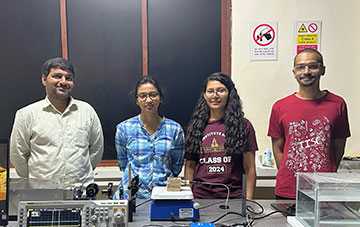![]()
The setup used in the photoacoustic experiments at the Indian Institute of Science. [Image: G. Puneeth]
Could noninvasive photoacoustic sensing detect blood glucose levels in diabetic patients without piercing their skin? Researchers in India are building the foundation for future instrumentation that could perform such measurements.
The scientists developed a proof-of-concept system that uses near-infrared photoacoustic sensing to correlate optical rotation with concentrations of glucose and other molecules in solution, at depths of several millimeters (Sci. Adv., doi:10.1126/sciadv.ado8012 ). The work could lead not only to needle-free glucose monitoring, but also improved detection of certain cancers.
Chirality and photoacoustic sensing
Many molecules—both those that occur naturally in the human body and those of many drugs—exhibit chirality: the inability to be superimposed on its mirror image. The two different versions of chiral molecules, called enantiomers, may act differently; for example, one enantiomer of thalidomide acts as a sedative while the other causes devastating birth defects.
Glucose, the most fundamental sugar molecule, also exhibits chirality, which changes the polarization of light that interacts with the molecule. But short-wavelength polarimetric methods don’t always work with living tissue because scattering effects within the tissue can depolarize optical signals.

The Indian Institute of Science lab group members working on developing photoacoustic imaging and sensing technologies. [Image: G. Puneeth]
Photoacoustic sensing uses laser light to heat biological tissue components slightly to induce thermoelastic expansion and contraction. The thermal changes produce a spectrum of ultrasonic waves that can be analyzed.
Demonstrating the concept
Swathi Padmanabhan and Jaya Prakash, two researchers at the Indian Institute of Science, dubbed their experimental technique photoacoustic-based polarization-enhanced optical rotation sensing, or PAPEORS. In their experiments, 1560-nm-wavelength light from a Nd:YAG laser passed through circularly polarizing optics and a magnetically stirred solution. An ultrasound transducer picked up the time-series photoacoustic signal.
The duo first studied glucose at various concentrations in solutions of either water or bovine serum albumin, as well as within 3-mm-thick slices of chicken breast-meat tissue. Then, the researchers tested the experimental setup on the finger of a human, both before and after the test subject consumed a meal. They compared the photoacoustic results to those from a standard glucose meter that relies on finger-pricking and drops of blood.
According to the researchers, PAPEORS has a detection limit of 80 mg/dl, and the photoacoustic signals from the subject’s finger increased after each meal as the person’s glucose level rose. The benchtop apparatus needs to be miniaturized for practical use, but the scientists believe the technique holds promise for future glucose monitoring.
